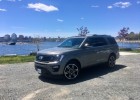
By Kevin Harrison
I once wrote a column on electric cars for the wheels section of a newspaper that shall remain nameless. The editor of this particular wheels section read it on a Friday and wrote back to me saying it was one of the best automotive related columns he had read in a long time.
When Monday came along he had emailed me to tell me he re-read it several times over the weekend and came to the conclusion that he couldn’t publish it. Not only that, he decided to boot me off my bi-weekly column completely.
Like most wheels “news” sections, their very existence is completely dependent on advertising. And guess who tends to advertise in the wheels section? That’s right, automakers.
Because of this, writing anything negative or anything perceived to be negative about any car or any automaker is unacceptable as it runs the risk of having the advertising pulled (this, by the way, is the reason why you shouldn’t rely on this sort of “journalism” as a credible source of information). I was told of this after a column I had written before had to have some parts edited out due to negativity (aka much warranted criticism). I was warned never to do it again, so I didn’t.
So you can imagine my surprise on the said Monday when my editor, after reading the best automotive related column he’s read in a while, gave me the boot. He cited negativity as the reason.
From what I understand, the negative part my editor cited was when I quoted two CEO’s from Honda and Toyota stating that they did not see a future in investing in electric vehicles. They also complained about government rebates only being available on electric vehicles and no other efficient cars like, say, hybrids.
Strictly speaking, it was them making negative comments, not me. I merely quoted them for the sake of presenting the other side of the argument; as you do with good balanced journalism. If manufacturers don’t want negative things said about themselves in the media then perhaps they should start by telling their CEO’s to not make negative comments to the media, which is fair game to be quoted at any time.
But I digress.
The more interesting part of this story is that Honda and Toyota were coming out against electric vehicles, and this was just in 2009. And what’s more, Honda now has an all-electric Fit available in Japan. Clearly something has changed along the way.
But what I should have been focusing on back then was what one automaker is doing in terms of electric vehicles. Ford is one that sees value in electric vehicles, so much so that it offers three varieties of electrified vehicles.
Ford has invested in full electric, partial electric and hybrid vehicles in at least three models. That’s right, if you march into a Ford dealership today you can have your choice of a full-on electric Focus, a plug-in hybrid in the form of the Fusion or C-MAX or a regular hybrid in the Fusion and C-MAX.
Recently, I had the chance to sit down with Dean Geddes, marketing strategy manager for Ford Canada at an energy conference here in Halifax (full disclosure: I work for the company who put on the conference). I asked him about Ford’s dedication to electrified vehicles and even asked about their sustainability practices.
“Sustainable materials are a critical aspect to our success,” said Geddes. “For instance we use up to ten pounds of jeans and t-shirts in our sound absorption materials, we use soy bean based foam in our seat cushions and head restraints, we also use sugar cane and wheat straw for plastic bins and door panels”.
“We’re partnering with universities and research centres to expand (our sustainability plan), for instance we’re looking at using Russian dandelions as an alternative for rubber,” Geddes continued.
But more than that, Ford truly believes in electrified vehicles.
“Our strategy is having the power of choice and best of both worlds… a lot of Canadians that are commuters travel under that level,” said Geddes about the number of Canadians who could benefit from electrified vehicles solely by the nature of their commute.
Geddes was not able to comment on whether Ford will be introducing more electrified vehicles to its portfolio but he did say that “we do anticipate that there’s going to be growth in electric vehicles over the next-5-10 year period. The technology is going to take off and is continuing to take off for Ford”.
In fact they are so confident that they lent me a Fusion Hybrid so I could experience what they’re on about.
This is not the first hybrid I’ve ever driven. Actually, this is not the first Ford hybrid I’ve ever driven either. Of the two hybrids Ford offers, I rather prefer the Fusion because, personally, I prefer the styling of the Fusion. It’s sleek, elegant and, as you’ve likely heard thousands of times by now, it looks like an Aston Martin Rapide for the middle classes. There’s nothing visually about the Fusion hybrid that shows it has an electric motor under the hood; just some badging.
Inside is the same story. The only clue you’ll get is when you start the car and seemingly nothing happens. In fact, the car is on and it’s ready to go. This is where the second giveaway comes into play. On the dash, you’ll get a notice that says ‘ready to drive’ since there’s no audible prompt, and you’ll also notice an abundance of leaves. This is part of the way Ford trains you to drive a hybrid to achieve its maximum efficiency. On the other side, it trains you on how to maximize the energy returned to the battery from braking by using a percentage.

I was asked on Twitter (follow me at @Car_Driven) if the quality in the Fusion was up to snuff. Indeed it is, in fact it borderlines on feeling like a premium car. There’s top notch materials throughout matched with quality feel. The only thing that felt a bit cheap was the key fob and the back plate constantly falling off didn’t help. But that goes to show just how far Ford has come in terms of quality if the only thing you can criticize is the key fob. As for the seats, they are very comfortable and you’d never know that they were made from sustainable materials. They feel pretty normal.
Rear legroom and headroom is adequate –unfortunately that swoopy shape cuts into the latter and makes it a bit difficult to get into the back, but once you’re in you should do just fine for room. Trunk space is fairly limited given the battery acts almost as a barrier between the seats –something most hybrid owners have come to accept; limited cargo capacity.
Under the hood you’ll find an Atkinson-cycle 2.0-liter making 141 horsepower. Add in the power from the electric motor and total output is 188 horsepower. The Fusion is no drag strip contender, but it doesn’t feel particularly sluggish. While the Fusion is a rather large car, it still has decent pick-up with you put your foot down. After all, it’s 123 pound lighter than the previous generation which also helps to get it off the line. Beware that if you do put your foot down, you’ll lose most of the leaves you built up that day.
As in most hybrids, the Fusion is equipped with a CVT transmission. CVT’s are the bane of automotive journalists existence (I confess to being one of them) but I must admit that this CVT isn’t so bad. It’s generally quiet, even when you have your foot down and it doesn’t feel harsh like other CVT’s do.
Fuel consumption is rated at 4.0 L/100 kms city and 4.1 L/100 kms highway. Those are very impressive figures – pretty much in Prius territory. I averaged 5.8 L/100 kms in mostly city driving and drove it as if it were a normal car – not a hybrid. Considering the Fusion’s size, that real world number is quite good.
In fact, driving the Fusion hybrid as a regular car is quite easy to do because you often forget you’re driving a hybrid in the first place. The steering is not stupidly numb like in most hybrids, there’s actually a bit of feedback. And despite sitting on rolling resistant tires, the Fusion doesn’t exactly feel out of sorts when cornering either. Really, aside from the visual graphics in the dash, the only things that gives it away as being a hybrid is the braking. I had the Fusion hybrid for about 4 days and still wasn’t able to master it. It’s very touchy at first than becomes very mushy feeling afterwards. This does not make it impossible to drive, it just makes for a bit of a jolty ride when braking.
If I were to re-write the column I wrote on electric cars four years ago I would have probably focused a bit more on Ford. They’re clearly in it for the long haul and they’ve proven that they can walk the talk as well. If I had focused on Ford, perhaps I’d still be writing for the wheels section of that newspaper today as they clearly have a more positive outlook. Then again, it would have prevented me from creating this website that you all know and love.
One thing is for sure, Ford has hit a homerun with the Fusion Hybrid and I would imagine the same could be said for the rest of their electrified vehicles.
Base Price: $29,999
Pros:
- Keeps regular Fusion’s good looks
- High quality interior
- Smooth and decently powerful
- Good real world fuel consumption numbers
- Sustainability overall
Cons:
- Difficult to get in the back
- Touchy brakes
- Limited trunk space
Immediate Competition:
- Honda Accord Hybrid
- Hyundai Sonata Hybrid
- Kia Optima Hybrid
- Toyota Camry Hybrid
- Volkswagen Jetta Hybrid
Overall: 8.5/10














